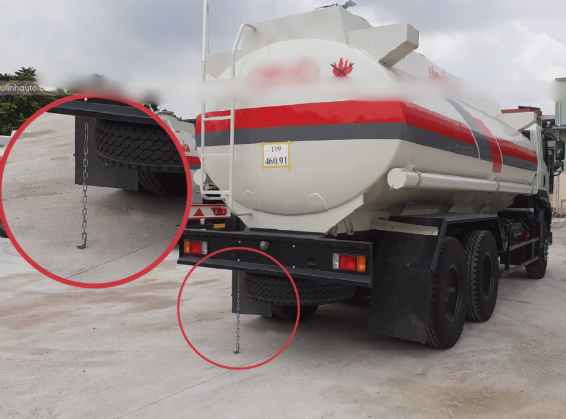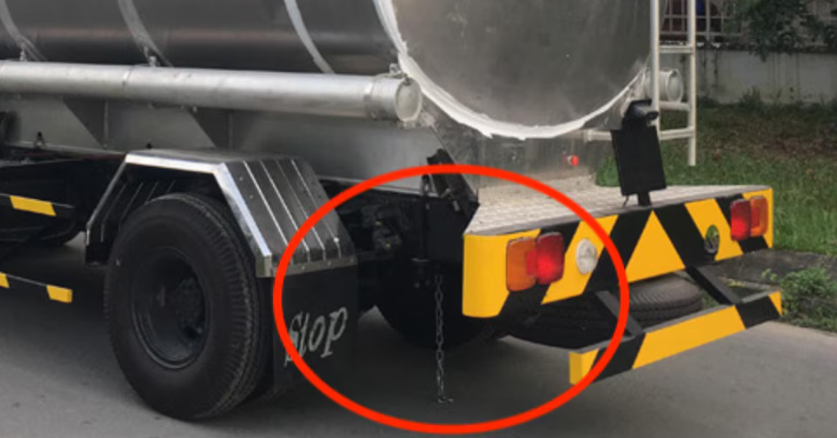If you’ve ever driven behind a tanker truck, you might have noticed a metal chain dangling from the back. While it might look like an afterthought or a misplaced tool, this chain serves a critical safety purpose, especially for trucks carrying flammable materials like gasoline or oil. In this article, we’ll delve into why these chains are essential, how they work to neutralize static electricity, and what alternative grounding methods are used in modern fuel transportation.
The Role of Static Electricity in Fuel Transportation

To understand why tanker trucks use chains, we first need to discuss static electricity. Static electricity builds up on surfaces due to friction—like when you rub a balloon on your hair, making it stick. In tanker trucks, especially those carrying flammable liquids, static electricity can pose a significant safety risk. Here’s why:
- How Static Electricity Builds Up: As the truck moves, the liquid inside the tank sloshes around, generating friction between the fuel, air, and tank walls. This movement builds up static electricity on the tank surface, creating an electrical charge.
- The Risk of Ignition: If this electrical charge isn’t safely discharged, it can result in a spark. When you’re transporting volatile substances like gasoline, even a small spark can ignite vapors and cause a fire or explosion.
So, how do tanker trucks manage this risk? This is where the grounding chain comes into play.
The Chain as a Grounding Tool
The metal chain hanging from the back of a tanker truck is a simple but effective way to ground the vehicle and prevent dangerous static electricity from accumulating. Let’s break down how this works:
- Conductivity of the Chain: The chain is typically made of metal, which is highly conductive. As the truck moves, the chain drags along the ground, creating a direct path for electrical charges to safely dissipate.
- Neutralizing Static Electricity: When the chain touches the ground, it provides a way for the built-up static electricity to flow from the truck into the earth. This grounding effect keeps the truck at a neutral electrical state, minimizing the risk of sparks.
By grounding itself constantly, the truck significantly reduces the likelihood of an accidental fire or explosion—a crucial safety measure when transporting flammable materials.
Static Electricity During Fuel Transfer: A Hidden Danger
Static electricity isn’t only a risk when the tanker is on the move. During loading and unloading, static charges can accumulate even more rapidly due to the movement of liquid fuel through the pipes and hoses. This makes grounding systems essential during fuel transfer as well.
- Discharge Risk During Fuel Transfer: When gasoline or oil is pumped into or out of the tanker, friction between the liquid and tank walls generates static electricity. If this electricity isn’t discharged, it can release as a spark, posing a significant danger.
- Additional Grounding Systems: Many fuel stations and tanker trucks use specialized grounding systems, like the Road Tanker Grounding (Earthing) system, which provides a reliable path for static charges to dissipate safely. This system is especially important during fuel transfers, where static electricity can accumulate quickly.
Other Grounding Methods for Tanker Trucks
While chains are one of the most visible grounding tools, they’re not the only method used to manage static electricity on tanker trucks. Advances in technology have introduced various grounding devices to enhance safety in fuel transportation:
- Static Dissipaters: These devices slowly release static electricity over time, reducing the overall build-up of charges. They provide an additional layer of protection beyond the grounding chain.
- Grounding Cables: In some cases, grounding cables are used to establish a direct connection from the truck to the ground, especially during fuel transfer. These cables provide a secure path for static charges to dissipate quickly and safely.
- Conductive Tires: Certain trucks are equipped with conductive tires that allow small amounts of static electricity to discharge directly through the tires. However, since this method may not be sufficient on its own, it’s often paired with other grounding tools for comprehensive protection.
Why Not All Tanker Trucks Have Chains

If grounding chains are so effective, you might wonder why not all tanker trucks have them. The use of chains depends on the type of cargo being transported, the specific safety requirements, and available technology. Here are a few reasons why chains might not be on every tanker:
- Non-Flammable Cargo: For tankers transporting non-flammable liquids, such as water or milk, there’s no risk of ignition, so grounding measures like chains aren’t necessary.
- Advanced Grounding Systems: Some trucks come with modern grounding technologies, such as static dissipaters and grounding cables, which eliminate the need for a chain.
- Varying Regulations: Safety regulations for grounding can differ from one region to another. In some areas, grounding chains are required by law, while in others, alternative methods may meet the safety standards.
The Science Behind Grounding and Electrical Neutralization

So, why is grounding so effective in managing static electricity? Here’s a simplified look at the science behind it:
- Electrical Imbalance: Static electricity is essentially an imbalance of electrical charges on a surface. When friction generates static on a tanker truck, it creates an electrical potential that seeks a path to discharge.
- Neutralization Process: By dragging the chain along the ground, the truck allows electrons to move from the truck into the earth, neutralizing the charge. This process prevents an imbalance that could otherwise result in a spark.
This straightforward grounding technology has been used for decades, proving itself as a reliable and cost-effective method to enhance safety in fuel transportation.
Conclusion: Why Chains Are Essential for Tanker Truck Safety
In fuel transportation, safety measures are critical to preventing accidents. The chain hanging from the back of a tanker truck may seem unremarkable, but it serves a vital role in grounding the vehicle, preventing static build-up, and reducing the risk of fire or explosion.
While chains are a traditional and effective grounding method, they’re often complemented by other modern safety devices, such as static dissipaters and grounding cables, to provide comprehensive protection. So, the next time you see a chain trailing behind a tanker truck, you’ll know it’s not just a quirky feature—it’s a life-saving tool designed to keep drivers, cargo, and everyone on the road a little safer.


